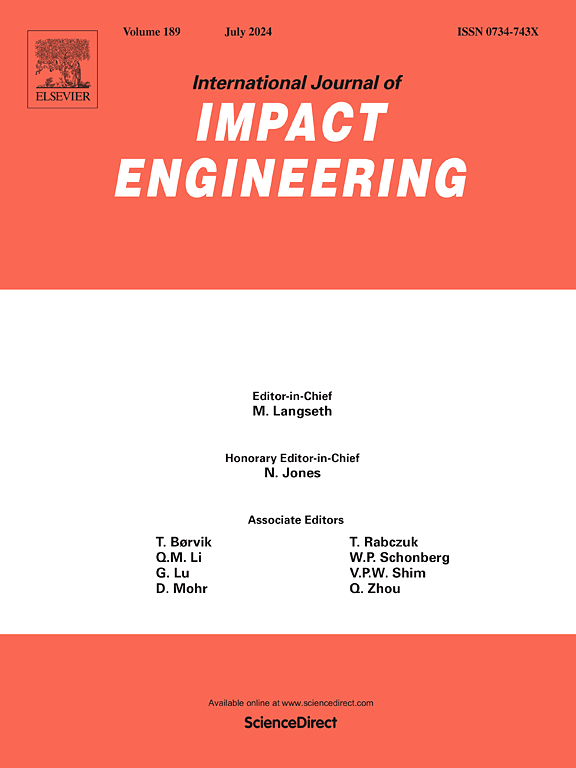Study of attitude deflection and trajectory yawing mechanism of concrete wedge-water layer combination structures for long rod ogive-nosed projectiles
IF 5.1
2区 工程技术
Q1 ENGINEERING, MECHANICAL
International Journal of Impact Engineering
Pub Date : 2025-05-09
DOI:10.1016/j.ijimpeng.2025.105392
引用次数: 0
Abstract
To explore an efficient deflection yaw anti-penetration protection structure, based on the attitude deflection and trajectory yawing phenomena of the projectile penetration into the special shape structure and the non-ideal entry of the projectile into the water. A concrete wedge and water layer combination structure is proposed to protect against the penetration of the ogive-nosed projectile. Ballistic impact tests and numerical simulations were conducted on the concrete wedge-water layer combination structure to evaluate its resistance against long-barreled ogive-nosed projectile penetration. The study analyzes the changes in forces, attitude, and trajectory during the projectile's penetration of the concrete wedge and water, and identifies typical projectile damage modes. The results show that during the penetration process, the concrete wedge induces initial attitude deflection and trajectory yaw in the projectile, asymmetric erosion of the head and overall bending deformation. After entering the water layer, sustained asymmetric forces apply to the projectile, leading to further bending deformation, sustained deflection and yawing motion. As the initial velocity increases, the projectile exhibits three distinct deformation and damage modes: asymmetric surface abrasion, asymmetric head deformation, and head erosion combined with overall bending.
长杆凸鼻弹混凝土楔水层组合结构姿态偏转与弹道偏航机理研究
基于弹丸侵彻特殊形状结构时的姿态偏转和弹道偏转现象以及弹丸入水的非理想入水情况,探索一种有效的偏转偏航防突防护结构。提出了一种混凝土楔形和水层组合结构,以防止锥形弹头的侵彻。对混凝土楔形水层组合结构进行了弹道冲击试验和数值模拟,以评估其抗长管锥形弹侵彻能力。研究分析了弹丸侵彻混凝土楔体和水时的力、姿态和弹道变化,确定了弹丸的典型毁伤模式。结果表明:在侵彻过程中,混凝土楔块引起弹体初始姿态偏转和弹道偏转,引起弹头非对称侵蚀和整体弯曲变形;进入水层后,持续的不对称力作用于弹丸,导致弹丸进一步弯曲变形,持续偏转和偏航运动。随着初速度的增加,弹丸呈现出三种不同的变形和损伤模式:非对称表面磨损、非对称头部变形和头部侵蚀合并整体弯曲。
本文章由计算机程序翻译,如有差异,请以英文原文为准。
求助全文
约1分钟内获得全文
求助全文
来源期刊

International Journal of Impact Engineering
工程技术-工程:机械
CiteScore
8.70
自引率
13.70%
发文量
241
审稿时长
52 days
期刊介绍:
The International Journal of Impact Engineering, established in 1983 publishes original research findings related to the response of structures, components and materials subjected to impact, blast and high-rate loading. Areas relevant to the journal encompass the following general topics and those associated with them:
-Behaviour and failure of structures and materials under impact and blast loading
-Systems for protection and absorption of impact and blast loading
-Terminal ballistics
-Dynamic behaviour and failure of materials including plasticity and fracture
-Stress waves
-Structural crashworthiness
-High-rate mechanical and forming processes
-Impact, blast and high-rate loading/measurement techniques and their applications
 求助内容:
求助内容: 应助结果提醒方式:
应助结果提醒方式:


